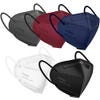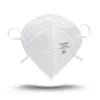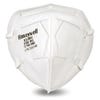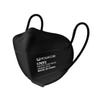




COVID, the flu and RSV cases are all rising. Wearing a mask in certain situations can lessen transmission of all three.

While we hate to say it, the pandemic has shown its staying power. In light of each subsequent variants' high transmutability and contagiousness, it's wise to keep some masks on hand for travel, large gatherings and high-density areas. Numbers are rising once again here in the United States, with 44 states reporting a troubling uptick in confirmed cases. This holiday season, much like the last one, could be a time with high transmission numbers, delayed flights and a lot of testing. One way to stymie the spread is to mask up.
With each variant of the COVID-19 virus that emerges, new challenges arise, meaning the scientists and frontline medical workers who are fighting it are constantly learning more about it. At the beginning of the pandemic, this meant promoting the use of cloth face masks for the vast majority of the population — both due to a shortage of medical masks but also because of their relative success in preventing the spread of COVID-19 and its variants at the time. The new variants, unfortunately, have been different beasts, and because they're so contagious (and the medical mask shortage has been managed), the newest guidelines implore everyone, vaccinated or not, to don more protective surgical-grade disposable face masks. In fact, the CDC's latest guidelines suggest that reusable cloth masks are not nearly as protective as once thought and that everyone should be making the switch to alternatives, like N95s and KN95s, whenever possible.
In addition to the ongoing COVID pandemic, we’re seeing one of the most intense early flu seasons in years along with rising numbers of RSV (respiratory syncytial virus). This is leading to a shortage of antibiotics and antiviral medication to go along with rising hospitalizations, especially among children and the immune-compromised. Experts have even gone so far as to dub the current situation as a “tripledemic.” The CDC also recommends wearing face masks to help stop the spread of the flu and RSV as well.
We know this might sound like a scary prospect — one that probably comes with some confusion, hesitance and a lot of questions. How do I even begin to shop for CDC-recommended face coverings? How can I tell if the masks I'm buying are real and not cheap, fraudulent knock-offs? What's the difference between the available mask grades on the market? Am I even wearing my mask right? If you've asked yourself any or all of these questions, we're here to help. This guide will cover all of that and more. Plus, we're including some recommendations for certified disposable face masks you can buy right now.
Disclaimer: This guide reflects the most current guidelines as outlined by the CDC, as of December 6, 2022.
Unfortunately, the CDC is not an international organization and, therefore, cannot account for face mask offerings outside of the United States. However, if you're an international reader, there are other governing bodies that have offered up equivalent protections. Using 3M's Respirator Class comparison chart, we've outlined those that most closely align with the CDC's present guidelines and most readily available in the US (for other internationally-certified options refer to the 3M chart). For more, you can see the CDC's approval list here. For further reading, the FDA has its own guide here. Keep in mind, the CDC is now suggesting that reusable cloth masks, like those made from cotton, should be looked at as a last resort and that the following options are preferred for better protection all-around.
At least as far as the United States is concerned, N95 masks are the standard for CDC-approved face coverings that will protect you best against the spread of COVID-19 and other airborne pathogens. This has not changed with the latest update to the CDC's guidelines. In fact, N95s are now at the top of the list of preferred masks, second to none. If you can find them, these are your best option. There are ratings higher than N95 (you can see them here), but N95 is the current, best baseline mask type as recommended by the CDC and protects against 95% of airborne particles.
Just as the name is remarkably similar, the performance of KN95 masks is roughly equivalent to N95s, with very little performance difference between the two (fractional differences, at best). The one major difference is that KN95 masks come from the Chinese rating system, whereas N95s are USA-specific regarding their rating. The one thing to look out for (which is outlined on this CDC page) is that something to the tune of 60 percent of KN95 masks available in the US are counterfeit — so you should either buy only from a reputable source you know you can trust or opt for an N95 option instead. Per the most current guidelines, KN95s are considered second only to N95s. Surgical-rated N95s are also not recommended.
Made to meet the EN14683 standard, this is a mask classification common in the European Union and is considered appropriate for medical usage where there is a risk of exposure to bodily fluids, including the kinds of droplets expelled in a cough or sneeze. They are amongst the options deemed appropriate for COVID-19 exposure.
This offering comes from South Korea and is roughly equivalent to N95s, although they're designed for public use (rather than medical) and they lack the same certifications as their occupational counterparts. Still, these masks are said to be roughly 94 percent effective at filtering out particles in the air and readily available in the States.
Unfortunately, the world is full of opportunists and people trying to make a quick buck, even if that means misleading people. This certainly hasn't changed with the emergence of the COVID pandemic. And that means there are a lot of masks that don't actually fit the CDC's recommendations. While it can be hard to navigate the thousands of options on the internet, there are a few things you can look for that will help ensure you're buying legitimate surgical-grade disposable face masks.
Short for the American Society for Testing and Materials, ASTM is an international "not-for-profit organization that provides a forum for the development and publication of international voluntary consensus standards for materials, products, systems and services." In laymen's terms, that means it sets rating requirements for a variety of products and practices to ensure that they are up to a specific quality. Regarding disposable face masks, those that meet both the CDC's current guidelines and those set by ASTM will feature a clearly-marked "ASTM F3502" or "ASTM F3502-21" (that "21" denotes the year) approval label.
Short for the National Institute for Occupational Safety and Health, NIOSH is actually a United States federal agency that's responsible for conducting research and making recommendations to help prevent workplace injuries, illnesses and more. As you might imagine, the U.S. government takes these workplace issues very seriously and, therefore, NIOSH criteria tend to be rather strict. In the case of disposable face masks, the organization offers two possible recommendations — "Workplace Performance" and "Workplace Performance Plus" — which both meet and mirror ASTM guidelines and require clear labeling for approved masks.
If you want to ensure that you have a mask that best meets the CDC's present guidelines, either or both of these label ratings will do the trick. However, labels are still relatively easy to counterfeit. As such, and if you want to be extra safe (which you should; it is a pandemic, after all), you can actually check the veracity of the label through NIOSH's Certified Equipment List (CEL, for short), using the included NIOSH TC approval number(s) from your mask's label or thumb through the full NIOSH-approved N95 list, and you'll instantly know whether you've got the real deal or a fake rip-off.
Though seemingly harder to verify than the above ratings, there are other certifications that qualify masks as being up to the current standards. According to the CDC, which can be seen on this Emergency Considerations PPE page, masks that have been given EU MDD Directive 93/42/EEC Category III or equivalent, EN 14683 Type II, IIR, ASTM F2100 minimum Level 1 or equivalent ratings are all approved for usage by medical professionals interacting directly with COVID-19 patients and, therefore, are protective for everyday usage, as well.
Now that you know what to look for, how the CDC's guidelines work and even how to properly wear your disposable face mask to ensure it's as effective as possible, the final step is finding the options that work best for you based on availability, budget and even style. The following disposable face masks are all readily available and meet the present criteria as outlined by the CDC.
Disclaimer: To the best of our knowledge, these masks all meet the standards set by the CDC, NIOSH, ASTM and/or some other similar governing and/or regulating body. However, with the number of counterfeits out there, we'd still suggest using your best judgment, being cautious and checking the veracity of the certifications via the available approval lists (here and here).